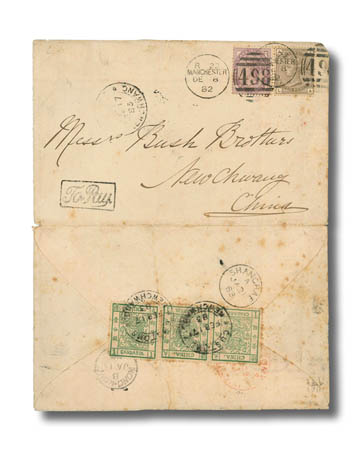郵票收藏
介紹郵票,明信片和其它藏品
China, Large Dragon (Cover) : 1882 (8 Dec.) envelope from Manchester to Newchwang (17.2.83) bearing Great Britain 1d. and 4d. grey-brown plate 18, cancelled by "Manchester/498" duplex, and showing on reverse "Hong Kong/B" (15.1.83) and "Shanghae/A" (21.1.83) c.d.s. of the British Post Office, "Customs/Shanghai" double-ring transit d.s. (22.1.83) in red, and "To Pay" framed h.s. (on front) applied at the Customs Post in Shanghai, with 1878 thin paper 1ca. green pair with sheet margin at right overlapped by a single, applied on arrival and cancelled by "Customs/Newchwang" double-ring d.s. of "Feb 17 83", the envelope opened out for display and some age spotting, vertical filing fold crosses one row of perfs. of one of the 1ca. stamps, one of which has a blunt corner, not really having any effect on the exceptional nature of this important and remarkable cover. Chan 1.
Estimate HK$ 2,000,000 - 2,500,000
Provenance: Michael Newbury, Robert A. Siegel (New York), 7.2.1962, lot 120
Sir Percival David, Robson Lowe (Basel), 20.3.1975, lot 1017. In his description, Robson Lowe wrote that this is "an outstanding cover and probably that of the greatest rarity among Large Dragon covers".
C.L. Kao
Ryohei Ishikawa, Sotheby's (London), 4-5.12.1980, lot 607.
References: James B. Whang, A Comprehensive Illustration on Covers of the Large Dragons (Taipei, 1997), pp. 307-308. Illustrated.
Directorate General of Posts, Ministry of Communications, Republic of China, The Revenue Surcharges China 1897, Vol. II (Taipei, 1987), p. 916.
THE UNIQUE INCOMING COVER TO NEWCHWANG WITH "TO PAY" HANDSTAMP AND LARGE DRAGON FRANKING APPLIED ON ARRIVAL
THIS IS THE ONLY RECORDED EXAMPLE OF THE "TO PAY" HANDSTAMP USED ON A LARGE DRAGON COVER.
The 3 candarins domestic rate applicable for foreign mail to north China.
Since China was not a member of the U.P.U., mail to places in China other than Shanghai was subject to domestic postage upon arrival in China. Overseas mail destined for northern China arrived through the ports of Shanghai or Tientsin (actually the deep water port of Tongku where there was a permanent Customs postal official). In the case of Shanghai, a "To Pay" instructional marking was applied as an indication to the appropriate local postal authority that the internal postage needed to be collected from the addressee.




